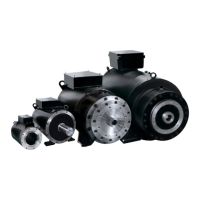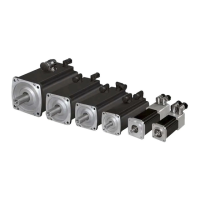TAM 00621 11
DSD 45-100 05/2007
Three-phase synchronous motor English
3 Mounting
3.1 Safety instructions
Before mounting:
Never mount or commission a damaged electric motor.
Never install the electric motor in a damaged machine.
Before installing the electric motor, make sure it is suitable for your machine.
Before mounting:
Only mount the motor using the fastening features provided.
The motor should not be exposed to knocks, e.g. with a hammer, or shocks during
mounting.
Make sure that all covers and safety devices are in place.
All safety devices must comply with the latest regulations (e.g. EN 60204).
3.2 Installation, fixing
Prior to and during mounting, check that
• The motor is not damaged (e.g. the shaft sealing ring must not be damaged in any way as a
result of contact with sharp or pointed objects).
• The motor is not mounted within the danger zone of other equipment.
• The motor is being used for the designated purpose (see Sections 1.2 and 2.4).
(Observe nameplate data, warning labels and signs.)
• All traces of anti-corrosion agents have been removed from the shaft end.
If you are using standard solvents such as acetone or petroleum ether, make sure that the shaft sealing
ring does not get wet!
• The motor has been designed for the local ambient conditions and environmental influences
(see Section 2.4).
• The compartment in the machine is suitable for the cooling method employed for the electric
motor (see Section 2.6).
The motor must be installed in such a way as to allow adequate heat dissipation via the surfaces of the
housing and motor flange.
• The motor can be mounted and operated using fastening features and connection data
provided.
The mounting dimensions of the motor and the tolerance details are provided in the technical
documentation that accompanies the product.
When mounting the motor, make sure that the flange surface connects properly and evenly. The
supports and bearing surfaces must be clean and undamaged. They must be precisely aligned with the
connecting shafts to prevent the bearings, shafts and housing being exposed to damaging loads as a
result misalignment. When tightening the flange fixing screws (min. property class 8.8), make sure that
the flange connection is not distorted.
• No liquid can penetrate the upper bearing when installing vertically with the shaft end facing
upwards.
• The permissible radial forces as defined by the operating characteristics in the technical
documentation are not exceeded (if necessary, contact Baumüller).
The motor manufacturer must always be contacted in the case of axial forces.
• The brake (available as an option) can be released once the operating voltage is applied
(audible operating noise).
• The rotor rotates smoothly without a scraping sound.
In the case of motors with an integrated brake, release the brake first.

